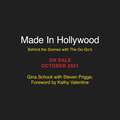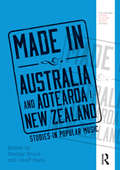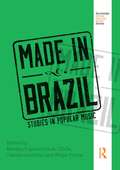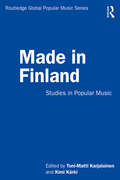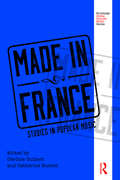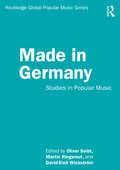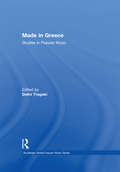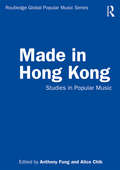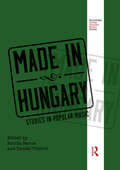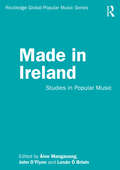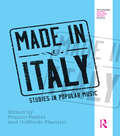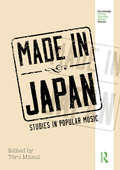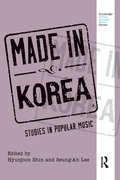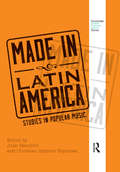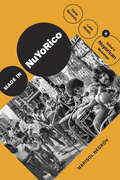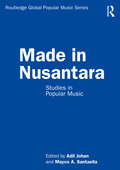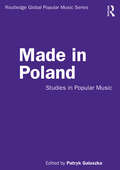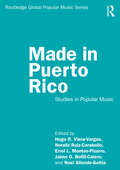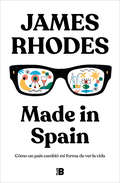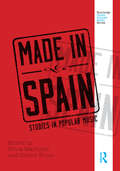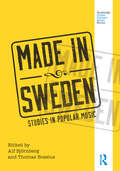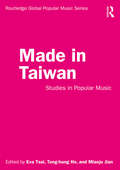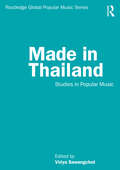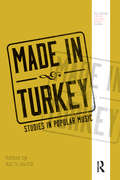- Table View
- List View
Made In Hollywood: All Access with the Go-Go’s
by Gina SchockThe Go-Go&’s were the first all-female rock group in history to write their own songs, play their own instruments, and reach the top of the Billboard charts with their #1 album, Beauty and the Beat. Made In Hollywood is drummer Gina Schock&’s personal account of the band, which includes a treasure trove of photographs and memorabilia collected over the course of her 40-year career.The Go-Go&’s debut album, Beauty and the Beat, rose to the top of the charts in 1981 and their hit songs "We Got the Beat", "Our Lips Are Sealed", &“Vacation&”, and "Head Over Heels" (to name a few) served as a soundtrack to our lives in the &‘80s.Now, after the release of their Critics Choice Award-winning Showtime documentary, and in anticipation of their forthcoming induction into the Rock & Roll Hall of Fame and their 2021 West Coast shows, Gina takes fans behind the scenes for a rare look at her personal images documenting the band's wild journey to the heights of fame and stardom. Featuring posters, photographs, Polaroids, and other memorabilia from her archives, Made In Hollywood also includes stories from each member of the Go-Go&’s, along with other cultural luminaries like Kate Pierson, Jodie Foster, Dave Stewart, Martha Quinn, and Paul Reubens.With a style as bold and distinctive as any Go-Go&’s album, Made In Hollywood is the perfect tribute to one of the world's most iconic groups.
Made in Australia and Aotearoa/New Zealand: Studies in Popular Music (Routledge Global Popular Music Series)
by Geoff Stahl Shelley BruntMade in Australia and Aotearoa/New Zealand: Studies in Popular Music serves as a comprehensive and thorough introduction to the history, sociology, and musicology of twentieth-century popular music of Australia and Aotearoa/New Zealand. The volume consists of chapters by leading scholars of Australian and Aotearoan/New Zealand music, and covers the major figures, styles, and social contexts of pop music in Australia and Aotearoa/New Zealand. Each chapter provides adequate context so readers understand why the figure or genre under discussion is of lasting significance to Australian or Aotearoan/New Zealand popular music. The book first presents a general description of the history and background of popular music in these countries, followed by chapters that are organized into thematic sections: Place-Making and Music-Making; Rethinking the Musical Event; Musical Transformations: Decline and Renewal; and Global Sounds, Local Identity.
Made in Brazil: Studies in Popular Music (Routledge Global Popular Music Series)
by Martha Tupinamba de Ulhoa Cláudia Azevedo Felipe TrottaMade in Brazil: Studies in Popular Music serves as a comprehensive and thorough introduction to the history, sociology, and musicology of twentieth-century Brazilian popular music. The volume consists of essays by scholars of Brazilian music, and covers the major figures, styles, and social contexts of pop music in Brazil. Each essay provides adequate context so readers understand why the figure or genre under discussion is of lasting significance to Brazilian popular music. The book first presents a general description of the history and background of popular music in Brazil, followed by essays that are organized into thematic sections: Samba and Choro; History, Memory, and Representations; Scenes and Artists; and Music, Market and New Media.
Made in Finland: Studies in Popular Music (Routledge Global Popular Music Series)
by Toni-Matti KarjalainenMade in Finland: Studies in Popular Music serves as a comprehensive and thorough introduction to the history, culture, and musicology of twentieth and twenty-first century popular music in Finland. The volume consists of essays by leading scholars in the field, and covers the major figures, styles, and social contexts of popular music in Finland. Each essay provides adequate context so readers understand why the figure or genre under discussion is of lasting significance. The book is organized into five thematic sections: Emerging Foundations of Popular Music in Finland; Environments, Borderlines, Minorities; Transnationalisms; Sounds from the Underground; and Redefining Finnishness.
Made in France: Studies in Popular Music (Routledge Global Popular Music Series)
by Gérôme Guibert Catherine RudentMade in France: Studies in Popular Music serves as a comprehensive introduction to the history, sociology, and musicology of contemporary French popular music. The volume consists of essays by scholars of French popular music, and covers the major figures, styles, and social contexts of pop music in France. The book first presents a general description of the history and background of popular music in France, followed by essays that are organized into thematic sections: The Mutations of French Popular Music During the "Trente Glorieuses"; Politicising Popular Music; Assimilation, Appropriation, French Specificity; and From Digital Stakes to Cultural Heritage: French Contemporary Topics. Contributors: Christian Béthune Juliette Dalbavie Gérôme Guibert Fabien Hein Olivier Julien Marc Kaiser Barbara Lebrun David Looseley Stéphanie Molinero Anne Petiau Cécile Prévost-Thomas Vincent Rouzé Catherine Rudent Matthieu Saladin Jedediah Sklower Raphaël Suire Florence Tamagne
Made in Germany: Studies in Popular Music (Routledge Global Popular Music Series)
by Oliver SeibtMade in Germany: Studies in Popular Music serves as a comprehensive introduction to the history, sociology, and musicology of contemporary German popular music. Each essay, written by a leading scholar of German music, covers the major figures, styles, and social contexts of pop music in Germany and provides adequate context so readers understand why the figure or genre under discussion is of lasting significance. The book first presents a general description of the history and background of popular music in Germany, followed by essays organized into thematic sections: Historical Spotlights; Globally German; Also "Made in Germany"; Explicitly German; and Reluctantly German.
Made in Greece: Studies in Popular Music (Routledge Global Popular Music Series)
by Dafni TragakiMade in Greece: Studies in Popular Music serves as a comprehensive and thorough introduction to the history, sociology, and musicology of contemporary Greek popular music. Each essay covers the major figures, styles, and social contexts of pop music in Greece, first presenting a general description of the history and background of popular music in Greece, followed by essays, written by leading scholars of Greek music, that are organized into thematic sections: Hugely Popular, Art-song Trajectories, Greekness beyond Greekness, Counter Stories, and Present Musical Pasts.
Made in Hong Kong: Studies in Popular Music (Routledge Global Popular Music Series)
by Anthony Fung Alice ChikMade in Hong Kong: Studies in Popular Music serves as a comprehensive and thorough introduction to the history, sociology, and musicology of twentieth- and twenty-first century popular music in Hong Kong. The volume consists of essays by leading scholars in the field, and it covers the major figures, styles, and social contexts of popular music in Hong Kong. Each essay provides adequate context to allow readers to understand why the figure or genre under discussion is of lasting significance. The book is organized into four thematic sections: Cantopop, History and Legacy; Genres, Format, and Identity; Significant Artists; and Contemporary Cantopop.
Made in Hungary: Studies in Popular Music (Routledge Global Popular Music Series)
by Emília Barna Tamás TófalvyEmília Barna is Assistant Professor at the Budapest University of Technology and Economics. She is a founding member and Chair of IASPM Hungary, editor of Zenei Hálózatok Folyóirat (Music Networks Journal), and Advisory Board Member of IASPM@Journal. Tamás Tófalvy is Assistant Professor at the Budapest University of Technology and Economics. He was the founding Chair and is the current Vice-Chair of IASPM Hungary.
Made in Ireland: Studies in Popular Music (Routledge Global Popular Music Series)
by John O'Flynn Áine Mangaoang Lonán Ó BriainMade in Ireland: Studies in Popular Music serves as a comprehensive and thorough introduction to the history, sociology and musicology of 20th- and 21st-century Irish popular music. The volume consists of essays by leading scholars in the field and covers the major figures, styles and social contexts of popular music in Ireland. Each essay provides adequate context so readers understand why the figure or genre under discussion is of lasting significance to Irish popular music. The book is organized into three thematic sections: Music Industries and Historiographies, Roots and Routes and Scenes and Networks. The volume also includes a coda by Gerry Smyth, one of the most published authors on Irish popular music.
Made in Italy: Studies in Popular Music (Routledge Global Popular Music Series)
by Franco Fabbri Goffredo PlastinoMade in Italy serves as a comprehensive and rigorous introduction to the history, sociology, and musicology of contemporary Italian popular music. Each essay, written by a leading scholar of Italian music, covers the major figures, styles, and social contexts of pop music in Italy and provides adequate context so readers understand why the figure or genre under discussion is of lasting significance to Italian popular music. The book first presents a general description of the history and background of popular music, followed by essays organized into thematic sections: Themes; Singer-Songwriters; and Stories.
Made in Japan: Studies in Popular Music (Routledge Global Popular Music Series)
by Toru MitsuiMade in Japan serves as a comprehensive and rigorous introduction to the history, sociology, and musicology of contemporary Japanese popular music. Each essay, written by a leading scholar of Japanese music, covers the major figures, styles, and social contexts of pop music in Japan and provides adequate context so readers understand why the figure or genre under discussion is of lasting significance. The book first presents a general description of the history and background of popular music, followed by essays organized into thematic sections: Putting Japanese Popular Music in Perspective; Rockin’ Japan; and Japanese Popular Music and Visual Arts.
Made in Korea: Studies in Popular Music (Routledge Global Popular Music Series)
by Hyunjoon Shin and Seung-Ah LeeMade in Korea: Studies in Popular Music serves as a comprehensive and thorough introduction to the history, sociology, and musicology of contemporary Korean popular music. Each essay covers the major figures, styles, and social contexts of pop music in Korea, first presenting a general description of the history and background of popular music in Korea, followed by essays, written by leading scholars of Korean music, that are organized into thematic sections: History, Institution, Ideology; Genres and Styles; Artists; and Issues.
Made in Latin America: Studies in Popular Music (Routledge Global Popular Music Series)
by Julio Mendívil Christian Spencer EspinosaMade in Latin America serves as a comprehensive introduction to the history, sociology, and musicology of contemporary Latin American popular music. Each essay, written by a leading scholar of Latin American music, covers the major figures, styles, and social contexts of popular music in Latin America and provides adequate context so readers understand why the figure or genre under discussion is of lasting significance. The book first presents a general description of the history and background of popular music, followed by essays organized into thematic sections: Theoretical Issues; Transnational Scenes; Local and National Scenes; Class, Identity, and Politics; and Gendered Scenes.
Made in NuYoRico: Fania Records, Latin Music, and Salsa’s Nuyorican Meanings (Refiguring American Music)
by Marisol NegrónIn Made in NuYoRico, Marisol Negrón tells the cultural history of salsa, tracing the music’s Nuyorican meanings over a fifty-year period that begins with the establishment of Fania Records in 1964 and how it capitalized on salsa’s Nuyorican imaginary to cultivate a global audience. Drawing on interviews with fans, legendary musicians, and music industry figures as well as analyses of songs, albums, films, and archival documents, Negrón shows how Nuyorican cultural and social histories became embedded in and impacted salsa music's flows during its foundational period in the mid-1960s and its boom in the 1970s. Salsa’s Nuyorican aesthetics challenged mainstream notions of Americanness and Puerto Ricanness and produced an alternative public sphere through which New York’s poor and working-class Puerto Ricans could contest racialization and colonial power. By outlining salsa’s complicated musical, cultural, commercial, racial, gendered, legal, and political entanglements, Negrón demonstrates its centrality to Nuyorican identity and subjectivity.
Made in Nusantara: Studies in Popular Music (Routledge Global Popular Music Series)
by Adil Johan and Mayco A. SantaellaMade in Nusantara serves as a comprehensive introduction to the history, sociology, ethnography, and musicology of historical and contemporary popular music in maritime Southeast Asia. Each essay covers major figures, styles, and social contexts of genres of a popular nature in the Nusantara region including Malaysia, Indonesia, Brunei, Singapore, and the Philippines. Through a critical investigation of specific genres and their spaces of performance, production, and consumption, the volume is organised into four thematic areas: 1) issues in Nusantara popular music; 2) history; 3) artists and genres; and 4) national vs. local industries. Written by scholars working in the region, Made in Nusantara brings local perspectives to the history and analysis of popular music and critically considers conceptualisations developed in the West, rendering it an intriguing read for students and scholars of popular and global music.
Made in Poland: Studies in Popular Music (Routledge Global Popular Music Series)
by Patryk GaluszkaMade in Poland: Studies in Popular Music serves as a comprehensive introduction to the history, sociology, and musicology of contemporary Polish popular music. Each essay, written by a leading scholar of Polish music, covers the major figures, styles, and social contexts of pop music in Poland and provides adequate context so readers understand why the figure or genre under discussion is of lasting significance. The book first presents a general description of the history and background of popular music in Poland, followed by essays organized into thematic sections: Popular Music in the People’s Republic of Poland; Documenting Change and Continuity in Music Scenes and Institutions; and Music, Identity, and Critique.
Made in Puerto Rico: Studies in Popular Music (Routledge Global Popular Music Series)
by Edited by Hugo R. Viera-Vargas, Noraliz Ruiz-Caraballo, Errol L. Montes-Pizarro, Jaime O. Bofill-Calero, and Noel Allende-GoitíaMade in Puerto Rico: Studies in Popular Music serves as a comprehensive introduction to the history, culture, and musicology of 20th and 21st century popular music in Puerto Rico. The essays in this volume, written by both local experts and leading scholars, contextualize under-researched areas of Puerto Rican popular music-making in relation to ideologies, aesthetics, and symbolism, and propose new ways of thinking about Puerto Rican musical cultures.A groundbreaking introduction to Puerto Rican musical culture, the volume covers the major figures, styles, and social contexts of popular music in Puerto Rico, while also going beyond conventional narratives. Rather than simply providing histories of key genres, these insightful essays focus on the ways in which Puerto Rican musicians reimagine their distinctive musical language as it transmutes from local practices into global expressions.Offering both a survey of Puerto Rican popular music and pathways into deeper critical inquiry, Made in Puerto Rico is an essential resource for scholars and students of music and of Puerto Rican, Caribbean, Latin American, and African Diaspora Studies.
Made in Scotland: Studies in Popular Music (Routledge Global Popular Music Series)
by John Williamson Simon Frith Martin CloonanMade in Scotland: Studies in Popular Music serves as a comprehensive and thorough introduction to the history, politics, culture, and musicology of twentieth- and twenty-first-century popular music in Scotland. The volume consists of essays by local experts and leading scholars in Scottish music and culture, and covers the major figures, styles, and social contexts of popular music in Scotland. Each essay provides adequate context so readers understand why the figure or genre under discussion is of lasting significance. The book includes a general introduction to Scottish popular music, followed by essays organized into three thematic sections: Histories, Politics and Policies, and Futures and Imaginings. Examining music as cultural expression in a country that is both a nation and a region within a larger state, this volume uses popular music to analyse Scottishness, independence, and diversity and offers new insights into the complexity of cultural identity, the power of historical imagination, and the effects of power structures in music. It is a vital read for scholars and students interested in how popular music interacts with and shapes such issues both within and beyond the borders of Scotland.
Made in Spain: Cómo un país cambió mi forma de ver la vida
by James RhodesMade in Spain es un testimonio sincero, unas veces agridulce y otras lleno de humor, que nos recuerda el poder de las segundas oportunidades. Alguna vez has querido volver a empezar? Un nuevo comienzo, un nuevo hogar, una nueva familia. Una nueva vida… El pianista James Rhodes recrea en este libro el largo camino que emprendió cuando decidió dejar atrás el drama sufrido en el Reino Unido para encontrar, por fin, su verdadero lugar en el mundo. Desde su llegada a España hasta su historia de amor (tanto por un país como por una mujer), pasando por su fascinación gastronómica(«nada que ver con la paella de Jamie Oliver»), las batallas políticas, la pena, el choque cultural y su descubrimiento de la lengua española, Rhodes nos lleva, página tras página, a través de un relato que es un auténtico canto a lo mejor de la vida. «Necesitaba escribir este libro. Un viaje de la angustia a la felicidad. Una carta de amor al país que me ha regalado un hogar.» Reseñas:«James Rhodes tiene el don de saber crear libros únicos e inclasificables, llenos de humor, verdad, valentía y emoción. Made in Spain sigue esta regla y añade, para los españoles, un espejo en el que mirarnos y quizá hasta curarnos de algunos complejos».Rosa Montero «James Rhodes es un caso singular. Merece la pena escuchar su música y leer sus libros.»Eduardo Mendoza «Made in Spain debería ser de lectura obligatoria para todos los que a veces nos olvidamos de que, a pesar de todo, el nuestro es un gran país.»Juan Gómez-Jurado
Made in Spain: Studies in Popular Music (Routledge Global Popular Music Series)
by Sílvia Martínez Héctor FouceMade in Spain: Studies in Popular Music will serve as a comprehensive and rigorous introduction to the history, sociology and musicology of 20th century Spanish popular music. The volume will consist of 16 essays by leading scholars of Spanish music and will cover the major figures, styles and social contexts of pop music in Spain. Although all the contributors are Spanish, the essays will be expressly written for an international English-speaking audience. No knowledge of Spanish music or culture will be assumed. Each section will feature a brief introduction by the volume editors, while each essay will provide adequate context so readers understand why the figure or genre under discussion is of lasting significance to Spanish popular music. The book first presents a general description of the history and background of popular music, followed by essays organized into thematic sections.
Made in Sweden: Studies in Popular Music (Routledge Global Popular Music Series)
by Alf Björnberg and Thomas BossiusMade in Sweden: Studies in Popular Music serves as a comprehensive and rigorous introduction to the history, sociology and musicology of twentieth-century Swedish popular music. The volume consists of essays by leading scholars of Swedish popular music and covers the major figures, styles and social contexts of pop music in Swedish. Although the vast majority of the contributors are Swedish, the essays are expressly written for an international English-speaking audience. No knowledge of Swedish music or culture will be assumed. Each essay provides adequate context so readers understand why the figure or genre under discussion is of lasting significance to Swedish popular music; each section features a brief introduction by the volume editors. The book presents a general description of the history and background of Swedish popular music, followed by essays that are organized into thematic sections: The Historical Development of the Swedish Popular-Music Mainstream; The Swedishness of Swedish Popular-Music Genres; Professionalization and Diversification; and Swedish Artist Personas. Contributors: Jonas BjälesjöAlf BjörnbergThomas BossiusPeter DahlénOlle EdströmKarin L. ErikssonRasmus FleischerSverker Hyltén-CavalliusLars LilliestamUlf LindbergMorten MichelsenSusanna NordströmMarita RhedinHenrik Smith-SivertsenAnn WernerKajsa Widegren
Made in Taiwan: Studies in Popular Music (Routledge Global Popular Music Series)
by Eva Tsai Tung-Hung Ho Miaoju JianMade in Taiwan: Studies in Popular Music serves as a comprehensive introduction to the history, sociology, and musicology of contemporary Taiwanese popular music. Each essay, written by a leading scholar of Taiwanese music, covers the major figures, styles, and social contexts of pop music in Taiwan and provides adequate context so readers understand why the figure or genre under discussion is of lasting significance. The book first presents a general description of the history and background of popular music in Taiwan, followed by essays organized into thematic sections: Trajectories, Identities, Issues, and Interactions.
Made in Thailand: Studies in Popular Music (Routledge Global Popular Music Series)
by Viriya SawangchotMade in Thailand: Studies in Popular Music serves as a comprehensive and thorough introduction to the history, culture, and musicology of twentieth- and twenty-first century popular music in Thailand. The volume consists of essays by local experts and leading scholars in Thai music and culture, and covers the major figures, styles, and social contexts of popular music in Thailand. Each essay provides adequate context so readers understand why the figure or genre under discussion is of lasting significance.Discussing musical development and shift of sociocultural spheres of Thai popular music among nationhood, media platforms, and identity politics from the early years to the present, these scholars explore and rethink the connections between the development of Thai popular music and politics of music genres in Thailand. Made in Thailand includes a general introduction to Thai popular music, followed by essays organized into four thematic sections: Histories, Contemporary Issues, Politics of Sound, and Region and Cultural Politics. Offering a comprehensive look at popular music phenomena in the country, Made in Thailand is an essential resource for scholars and students in the fields of popular music studies, ethnomusicology, popular musicology, Asian studies, and Thai studies.
Made in Turkey: Studies in Popular Music (Routledge Global Popular Music Series)
by Ali C. GedikMade in Turkey: Studies in Popular Music serves as a comprehensive and thorough introduction to the history, sociology, and musicology of Turkish popular music. The volume consists of essays by leading scholars of Turkish music, and covers the major figures, styles, and social contexts of popular music in Turkey. Each essay provides adequate context so readers understand why the figure or genre under discussion is of lasting significance to Turkish popular music. The book first presents a general description of the history and background of popular music in Turkey, followed by essays that are organized into thematic sections: Histories, Politics, Ethnicities, and Genres.
